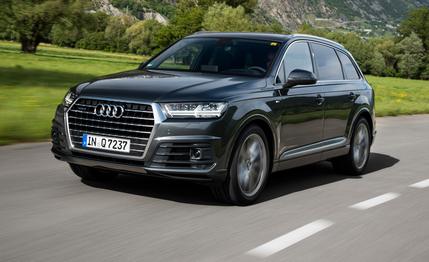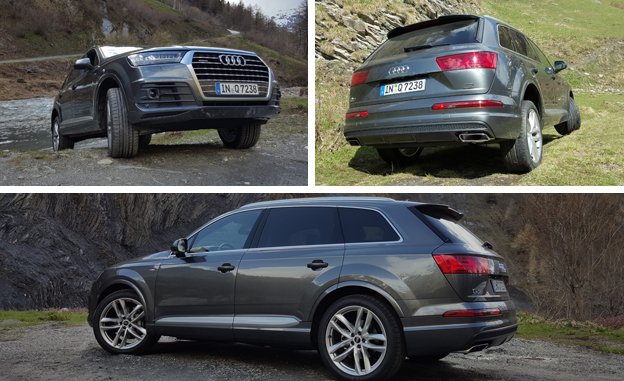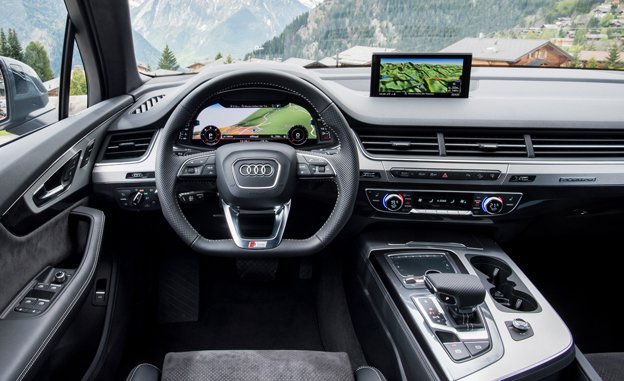 First Drive Review
First Drive Review
Audi has had plenty of time to get this one right: The four-ringed brand’s engineering team began to work on the second-generation Q7 SUV as early as 2009. And even then, the original was already four years old. Shown first as the Pikes Peak concept in January 2003, the production version bowed in 2005.
There are valid reasons why it took Audi six years to get the successor to market. During that period, Audi switched its development chief twice, and in both cases the car was thoroughly re-examined. Moreover, the new 2017 Audi Q7 is the pilot vehicle for the second-generation MLB architecture, which is very important for the VW Group—it serves as the basis for many future models from Audi, VW, Bentley, and Porsche. "The new Q7 needs to make a clean production launch," says R&D chief Ulrich Hackenberg. And there is another explanation: With more than 500,000 units sold worldwide, the previous model has been so successful that Audi was in no big hurry to replace it.
Given that success, the second-generation Q7 doesn’t need to convey a false sense of modesty, and it doesn't. The new version is one of the more aggressive-looking SUVs on the road. On paper, it’s a bit smaller than the previous model—and in fact, it has lost a couple of inches. But that is more than offset by its ostentatious new grille and its boxy fenders, which are supposed to allude to Audi's legendary Quattro coupe. The silver decorative trim on the lower flanks fails to cut the visual bulk, and, as before, the Q7 looks best with its optional extralarge 20- or 21-inch wheels.
Judging from the appearance, it’s hard to believe that more than 700 pounds have been cut out—per Audi—in the transition from old Q7 to new. Whatever the real-world weight loss manages to be, the sveltening is the result of changing from the previous model's off-road-centric platform to one shared with actual passenger cars. The new axles alone are said to shave a whopping 148 pounds, and the body makes liberal use of aluminum. You can read more about the weight-saving measures here.

The lighter Q7 is more efficient, and its drinking habits have become far more socially acceptable. The U.S. market gets a 3.0-liter TDI with 272 horsepower, as well as a 3.0-liter supercharged V-6 with 333 horsepower. Both engines have their strong points. Once the diesel has moved beyond its initial turbo lag and reached 1500 rpm or higher, it rides a massive, 443-lb-ft wave of torque. Yet the ZF-sourced eight-speed automatic helps mitigate any low-end dawdling with its adept gear selection. The diesel's soundtrack is muted, and it delivers its power with a subdued growl. Zero to 60 mph comes up in about six seconds, and the European model tops out at 145 mph. Figure on achieving something like 32 mpg on the highway, too.
Fuel consumption is the main disadvantage of the supercharged V-6; we figure it’s going to manage EPA figures of maybe 18 mpg in the city and 27 highway. Those numbers work fine for the U.S., though, where such economy isn’t actually so bad and gas is far cheaper than in Europe. The gasoline V-6 offers lightning-quick responses over a much wider rev band than the diesel. With this engine, the Q7 invites its driver to hustle down the nearest windy road. Really.
Yes, the new Q7 likes curves. Our test example was equipped with the adaptive air suspension, and we can confirm that it isn't just comfortable, but also that it can deliver a distinctly sporty driving character. Soft and comfy in Efficiency, Comfort, and Auto modes, it shows its playful side in the clearly delineated Dynamic mode. And the Q7 gets even better with the optional four-wheel-steering system, which improves stability at highway speeds while reducing the turning circle in the city. All-wheel drive is standard; the default torque split is slightly rear-biased at 40:60, but it can shift to as much as 70 percent up front or 85 percent to the rear. Two off-road modes help the Q7 go far beyond the beaten track, and ground clearance can be raised to 9.6 inches. There’s no low-range transfer case, however.

From the driver's seat, the Q7 emerges as the design leader. The interior is so contemporary, functional, and aesthetically pleasing that it may set the new class benchmark. We love the design and feel of the TFT instrument cluster, which corresponds to similar systems in the new TT and R8, especially since it’s augmented with a traditional screen in the dash. The user interface is intuitive and quick, although the cluster screen provides you with so much information and functionality, it’s hard not to worry about it being somewhat of a distraction. Driver and passengers enjoy plenty of comfort and space, and even the optional third-row seats are sufficiently spacious, although ingress and egress to the wayback is a hassle. Incidentally, the Q7 is so quiet that the stereo systems truly shine. We found the Bose sound package to be more than sufficient, enough so that we’d skip the far more expensive Bang & Olufsen system.
The Q7 comes with a plethora of electronic nannies, sensors, and technologies, which can be interpreted as a major step toward autonomous driving. They include brake-based torque vectoring; Traffic Jam Assist, which can essentially drive the Q7 on the highway at speeds of up to 40 mph; a trailering assistant that will back up and steer the trailer for you; and the latest versions of things like lane-departure warning and assist, blind-spot monitoring, auto braking, and adaptive cruise control. Further, Audi says the Q7 soon will add the ability to steer around obstacles in the road and brake the car if you make a left turn that will result in a collision with oncoming traffic. (Volvo also will offer the latter tech on its new XC90.) There’s also an efficiency assistant that keeps telling you to drive with a lighter right foot. We rarely complied with its wishes.
While the Q7 has taken a big step forward, things are about to get very crowded at the top of the SUV segment, with the upcoming entries from Bentley, Rolls-Royce, and even Mercedes-Maybach. To stay in that highly profitable game—and to retain the owners of the previous V-8 and V-12 TDI versions—Audi will launch a V-8 TDI, a V-8 turbo gasoline engine, and possibly even a W-12 turbo gasoline engine. Before that, however, we’ll see a plug-in-hybrid e-tron model. (Audi hasn’t yet decided whether it will bring Americans the previously detailed 3.0 V-6 diesel e-tron; a gasoline 2.0-liter turbo four is slated for our market sometime in 2016.) The 3.0 TDI and the 3.0 TFSI will come to the U.S. later in 2015 as 2016 models, at prices starting around $50K.
After this initial drive, it seems like the Q7’s long gestation was time well spent—and the SUV well worth waiting for.